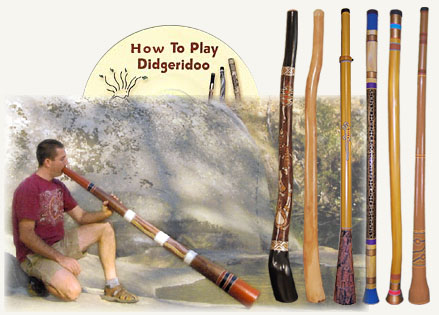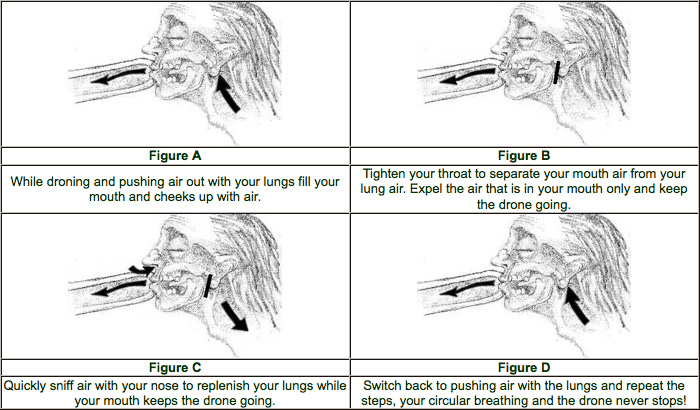
How Do You Play A Didgeridoo?
The technique of how to play the didgeridoo is unique among wood instruments. You blow down the tube with loose lips creating a vibration that echoes down the tube coming out amplified as a drone. Similar to a tuba but even looser and more relaxed. It is important to stay relaxed, trying too hard will tighten your muscles which contradicts the need to create loose lips and face. Buzz your lips while gently pushing air down the tube.
The
lip vibration is similar to giving someone a "raspberry". It can help
to stick your bottom lip out a little more than the top lip. To improve
the tonal quality of the drone it is important to try to tighten your
lips a little after the drone is started, this will increase the pitch
and really get the didgeridoo going! If you tighten up too much the
drone will abruptly stop and you get a sound we call the "Blow Out".
People often ask us how we can get a didge to play so loud and have such
an eerie quality to the drone. The secret to a good drone is starting
loose and tightening up the lips until you almost Blow Out. If you ride
the fine line of playing tightly with almost doing a "Blow Out" you can
achieve a loud and intense drone.
Getting
a good drone is critical because the other noises you make while
playing a didgeridoo happen while the drone is going. It takes most
people a bit of practice to be able to drone so don't get frustrated and
practice, practice, practice. But, you shouldn't really think of it as
practice because this instrument is fun to learn!
Now
try to drone as long as possible with one breath. While learning you
will waste a lot of air discovering how to make the noise. As soon as
possible start limiting the amount of air you use up. You only need
enough air to vibrate the lips, this is what creates the noise.
Didgeridoos can be made from a wide
variety of materials. Click here to see our modern didgeridoos.
Circular Breathing explained!
The
toughest part of didgeridoo playing is learning to circular breathe.
Circular breathing allows a player to be able to continually blow air
down the didgeridoo without ever stopping for breath. While
circular breathing is great to know it is NOT a requirement to be able
to play and enjoy this instrument. You can build breathing into rhythms
you create when you snatch air between beats. It is best to master the
other techniques of playing first and learn circular breathing last. Circular
breathing is what allows players to perform continuously without
stopping for breath. Many great wind instrument players such as Miles
Davis and Kenny G use circular breathing.
Practice these exercises to learn how to circular breathe:
Exercise 1:
Fill your mouth with water and push a stream of water out using only
your tongue and cheek muscles. Make sure not to use any pressure from
the lungs to help. Stay relaxed and breathe in and out with your nose
while making the stream. Keep trying until it feels very comfortable.
This is a good exercise to do in the shower!
Exercise 2:
Get a straw and a cup of water. Twist the end of the straw so that
almost no air can come out. Push air through the straw and into the
water creating bubbles. Breathe in and out with your nose while doing
this as in exercise 1. Keep the pressure even and the flow of bubbles
smooth.
Exercise 3:
Slowly transition to just breathing in with your nose and keep the
bubbles going nonstop. Master this until the muscle contractions you are
using feel totally comfortable and the bubbles are flowing smoothly.
Exercise 4:
You are now circular breathing. Keep your cup and straw right next to
you. Try to play your didge and circular breathe (it is just a bigger
straw). You will find this difficult so go right back to the straw and
water to practice again. Then, try on the didge again. Keep going back
and forth between the cup and water and the didge until you can
successfully do it on your didge.

Videos: